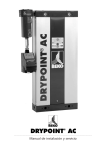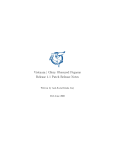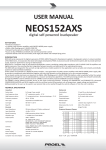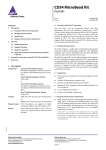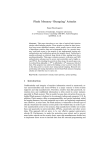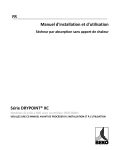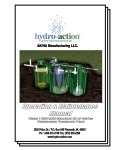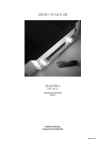Download Beko CDA 664 F Troubleshooting guide
Transcript
DRYPOINT AC ® Instruction & Technical Manual BEKO TECHNOLOGIES GMBH Im Taubental 7 D-41468 Neuss Tel. +49 / (0) 21 31 / 988-0 Fax. +49 / (0) 21 31 / 988-900 [email protected] Table of Contents Page: 1. Introduction ...................................................................................................................................................................... 3 2. Safety....................................................................................................................................................................................... 4 3. Description of the dryer’s main components................................................................................. 6 4. Explanation of the dryer’s main components ............................................................................... 7 5. Connecting the pre-filter to the dryer ................................................................................................... 8 5.2 Reconfiguration of the inlet and outlet ports............................................................................ 9 5.3 Installing the dryer in a horizontal orientation ..................................................................... 10 6. Installation ...................................................................................................................................................................... 11 7. Electrical supply......................................................................................................................................................... 12 8. Energy management and PC interfacing ......................................................................................... 14 9. Operation ......................................................................................................................................................................... 24 10. Start up ........................................................................................................................................................................... 25 11. Service and fault diagnosis......................................................................................................................... 26 12. Dryer troubleshooting ..................................................................................................................................... 35 13. Dryer sizing table .................................................................................................................................................. 37 14. Environmental conditions ............................................................................................................................ 38 15. EC Declaration of conformity ................................................................................................................... 39 2 | BEKO TECHNOLOGIES GMBH 1. Introduction The product to which this manual refers must not be supplied, installed, used, operated or serviced until the contents of the manual have been fully read and understood by all relevant personnel. This manual, and in particular the safety information, should be kept at the place of installation of the product. All relevant personnel must strictly follow instructions given in the manual. When contacting BEKO regarding this product or manual, please have the following information available: • Serial number: • Date of commissioning: The serial number can be found on the identification plate located at the upper right hand side of the unit and this information should be copied into this manual for future use. The dryer is delivered in protective packaging. Take care when transporting, loading and unloading the unit. The dryer is delivered configured for operation at the pressure mentioned in your order. It is important to ensure that the correct plug is fitted applicable to the operating pressure. See table on page 38 for further information. The dryer package includes: Instruction & Technical Manual | 3 2. Safety BEKO explicitly excludes all responsibility and liability for damage and/or injury caused by failure to follow the instructions described in this manual, or by failing to pay necessary attention when operating handling or servicing this product, even if not specifically stated in individual cases. The unit must be used for its intended purpose. The heatless-regenerating adsorption dryer is designed and manufactured exclusively for drying of compressed air within conditions as described in section 13 of this manual. Any other use of the unit will be considered inappropriate and BEKO shall not be liable, where this is permitted under law, for any damage incurred as a result of misuse. The following symbols give indication of potential hazard. Appropriate measures must be taken to reduce risk to any user or operator of the machine wherever such hazard exists. Warning: Caution: Caution: Risk of Danger Risk of High Pressure Risk of Electric Shock 4 | BEKO TECHNOLOGIES GMBH The following safety guidelines must be strictly observed: • Leave this manual at the place of installation of the product. • It is essential that only BEKO or their appointed agents carry out maintenance and servicing work. • Users, maintenance and servicing personnel must be familiar with: • accident prevention regulations • safety information (general and specific to the unit) • safety devices of the unit • measures to be taken in case of emergency • Allow only suitably trained persons to be involved with installation, start-up, operation, servicing and maintenance of the product. • It is the responsibility of the installer to ensure that the pipe work to and from the dryer is suitable, in accordance with applicable legislation and subject to inspection and testing prior to being put into service. All piping must be adequately supported. • Before carrying out any maintenance or servicing work the unit must be taken out of operation. Users and others will be exposed to risk if work is carried out whilst the unit is running. This means electrical disconnection plus isolation from the compressed air supply and full depressurisation. • Only trained and competent persons familiar with the electrical requirements of the unit as laid out in this manual and electrical safety rules and regulations should be allowed to carry out work on the electrical components and power supply to the unit. • When carrying out any work on the unit, use only correctly sized appropriate tools in good condition. • Only use original spare parts and accessories from the manufacturer. There is no guarantee that non-original parts have been designed and manufactured to meeting the safety and operational requirements of the unit. BEKO assume no liability for any equipment malfunction resulting from the use of non-approved parts. • If carrying out installation work above head height, use suitable and safe working platforms or other means of working access. • Do not make any constructional changes to the product. Any changes or modifications may only be carried out by the manufacturer. • Any faults or defects that could affect safety must be put right fully before using the unit. • Used items and materials must be disposed of in the correct manner, complying with local laws and regulations, in particular the desiccant cartridge. Instruction & Technical Manual | 5 3. Description of the dryer’s main components The figure below shows the main elements of a typical dryer unit. 15 16 12 11 17 13 19 14 Located on rear panel of dryer 1 9 2 8 10 3 18 6 7 5 4 1 Top valve assembly 10 Desiccant cartridge c/w dust filter 2 Control unit 11 Multiport manifold 3 Bottom valve assembly 12 Top cover 4 Bottom mounting block 13 Top cover fixing screw 5 Bottom valve fixing bolt 14 Rear panel 6 Front panel 15 DIN connector 7 Front panel fixing screw 16 Banjo fixing bolt 8 Pressure housing 17 Pressure seal 9 Pressure housing retaining bolt 18 Exhaust silencer 19 Purge plug 6 | BEKO TECHNOLOGIES GMBH 4. Explanation of the dryer’s main components 4.1 Control unit, item ref. 2 on page 6 The top and bottom valve blocks are operated by solenoids within the control unit that determine the pressure and direction of air flow into the desiccant cartridges. 4.2 Multiport manifold, item ref. 11 on page 6 The dryer is supplied as standard with inlet and outlet ports configured left to right as viewed from the front of the unit. There are several optional porting arrangements available by repositioning of port plugs. See also Section 5.2. 4.3 Desiccant cartridge c/w dust filter The cartridges contain the agent (desiccant) that has been developed for the drying of compressed air. The desiccant is housed in a clear tube that has a holder permeable to air at both ends. Located in the top of each cartridge is a 1-micron filter for removal of residual dust from the desiccant. The length of the cartridge varies with the flow capacity of the dryer. 4.4 Pressure housing The cartridges are contained within an extruded aluminium pressure housing and pressure retaining end plates. Process pressure and flow through each desiccant cartridge is controlled by means of top and bottom valve blocks located between the two pressure housings. The regenerating air flow (purge) is controlled by means of a small orifice plug located externally (front, central) on the top valve block and is accessible with the front panel removed. Instruction & Technical Manual | 7 5. Connecting the pre-filter to the dryer 1. Connect filter and DRYPOINT AC using proper sealing material and the fittings supplied. 2. If you are using the integrated condensate drain: Connect condensate outlet of filet with the condensate inlet on the back side of the dryer, using the tube supplied (4mm) diameter. Apply another discharge tube from the condensate outlet on the back side of the dryer into an oil water separator. If you are using a BEKOMAT 20FM condensate drain: Apply a discharge tube from the condensate drain outlet of the BEKOMAT 20FM into an oil water separator. All tubing should be secured up to the point of drain to prevent whipping during discharge. 5.1 Recommendation It is recommended that a bypass line including filter (not supplied) is installed. C A D B Figure 5.1 8 | BEKO TECHNOLOGIES GMBH 5.2 Reconfiguration of inlet and outlet ports OUTLETS INLETS 1. Port configuration as delivered: 3 inlet options left hand side of dryer as viewed from front. 5. Dryer with multiport manifold removed. 2. Remove top cover by means of 2 fixing screws 6. Rotate multiport manifold through 180º and replace by means of 4 fixing bolts. Ensure 2 ‘0’ rings in valve block are properly seated. 3. Dryer with top cover removed. 7. Replace top cover by means of 2 fixing screws. INLETS OUTLETS 4. Remove multiport manifold by means of 4 fixing bolts. 8. Port configuration following procedure above. Instruction & Technical Manual | 9 5.3 Installing the dryer in a horizontal orientation 1. Inlet filter is fitted to dryer in vertical orientation. Loosen fitting. 2. Turn filter by 90º 3. Inlet filter is fitted to dryer in vertical orientation. Tighten fitting. 4. Dryer in horizontal plane. Consideration must be given to supporting and to clearance for removal of inlet filter bowl. 10 | BEKO TECHNOLOGIES GMBH 6. Installation requirements Correct Wrong < 35°C > 35°C < 16 barg < 4 barg > 12 V < 12 V Correct Wrong Instruction & Technical Manual | 11 7. Electrical supply 7.1 Connection 1. The dryer is designed to operate on either an AC or DC supply voltage. Ensure only one power source is connected at any one time, and it is connected to the correct socket. Cover supplied must be fitted to the power connection not in use. 2. The power supply is to the DIN plug. No connection must be made to earth terminal 3. The dryer is double insulated therefore no earth is required. 4. Suitable external fuse connection must be provided. Figure 6.1 5. The cable selection must suit local installation regulations and be appropriate to power consumption. Supply Amp 12 VDC 0.8 24 VDC 0.4 100 VAC 0.16 115 VAC 0.14 230 VAC 0.07 240 VAC 0.067 12 | BEKO TECHNOLOGIES GMBH 7.2 DIN plug drawings Voltages: 100 to 240 VAC cover Voltages: 12 to 24 VDC cover Instruction & Technical Manual | 13 8. Energy management and PC interfacing 8.1 Interfacing the controller with a PC 8.1.1 Introduction to the software The dryer controller has the ability to interface with a PC. This gives the user or the service engineer the opportunity to interrogate the dryer to check the following: • Operating stage times • Service warnings • Operating history • Alarm settings • Fault history • Fault and service history • Real Time displays • Setting Energy Management Parameters – contact BEKO for details Connecting the PC to the controller 8.1.2 PC requirements Controller Application software: Windows 95, Windows 98,Windows 2000, Windows ME & Windows XP. 8.1.3 Installing the application software Simply load the CD into the PC and the software will automatically load-up and complete installation. The BEKO icon will be visible on the desktop. 8.1.4 Connecting the PC to the controller Ensure that power to controller is isolated Access to the controller is by removing the screw on the front panel, and removing the panel. Using the lead supplied connect the serial port connector to the PC. The RS232 connector is located on the underside of the controller. Remove the blanking plug taking care not to lose it and connect the RS232 connector with the latch to the front of the dryer. 14 | BEKO TECHNOLOGIES GMBH 1 Controller shown in the inverted position for reasons of clarity 2 3 1. Condensate solenoid valve 8 2. Tower 1 solenoid pilot valve 7 3. Tower 2 solenoid pilot valve 4. AC&DC supply DIN connections 5. Energy management DIN connection 4 6 6. Controller clear LED cover 7. RS232 Software connection 5 8. Alarm DIN connection Instruction & Technical Manual | 15 8.1.5 Starting the program If not already connected, connect the RS232 serial link cable between the controller and the host PC. Switch the power to the controller on. Launch the dryer application software by either double clicking the Walker Filtration icon found on the PC desktop or by clicking: Start > Programs > Walker Filtration > Dryer Application Software The first time the software is used the following window will appear. Choose your preferred language by clicking the appropriate flag. With the power to the dryer switched on the lead connecting the controller to the PC, double click the Walker Filtration icon on the screen. This will display the screen below, if the language is not as you require it then click the appropriate national flag and the next time the application software starts the language will be in the requested language. 1. Establish communication Click the “Establish Communication” switch on the screen this will look for the link between the PC and the dryer controller. 6 11 12 2 3 The serial number on the software must match the serial number on the controller to allow communications to be established. 9 1 7 10 4 13 5 8 If communication cannot be made, a warning will appear at the bottom of the screen. This may be due to the following: • Poor connections to the controller • Controller switched off • Application software/controller serial number mismatch Once communication has been established, click the “Read dryer” button on the screen this will then display the default setting from the works or the last setting the Service Engineer made. It is possible to change some of the controller settings from the factory default settings on the screen. This should only be done by a qualified service engineer. 16 | BEKO TECHNOLOGIES GMBH 8.1.6 Programming dryer Once it has been decided to change the default settings, and communications have been established and the dryer existing valves read the procedure for change is: • Click into the box you wish to change. • Over write with the items you require (note stage times are in 10 second intervals). • Click “Program dryer” ( a warning will appear asking to confirm the change). • Click to confirm and this will change operating parameter. • Click in real time to check set up. 2. Read dryer Reads the current settings of the controller 3. Program dryer Programs the controller with the new settings 4. Real Time view This screen can be opened by clicking the real time screen. In addition to the main display panel shown previously there is also a real time view, which illustrates the operation of the dryer valves as it happens. It also counts down the remaining time to run on the valve operation. This is useful in confirming faults, which are displayed with the LED’s on the front display panel. To view the status of the controller in real time, click the ‘real time’ view switch. A new window will appear animating the dryer controller status in real time. The following information is shown: • The stage the controller is in through its cycle, including remaining time on the particular stage. • Valve conditions • Power condition • Cartridge and valve service conditions • Energy management condition • Alarm condition 5. Load settings Allow previously stored settings to be loaded into the controller 6. Stage times • Tower 1 & Tower 2 – Indicates the time that a tower is depressurised. • Re-pressurization – Indicates the re-pressurization time set on the controller. • Link – Enables or disables the tower 1 & tower 2 settings to be linked. Instruction & Technical Manual | 17 7. Drain valve • Operate drain operation toggle - Allows the drain to operation to be toggled to function after both towers or only one tower. • Operate operation time- Sets the drain operation time. 8. Alarm settings Allows the service Engineer to toggle and adjust the remote alarm activation values from the default values. 9. Energy management Allows the user to set application parameters to save energy during periods of low demand. 10. Service information Indicates the default settings at which the cartridge and valve service indicators will illuminate. The service history of the machine is logged, giving total hours run and hours run since the last service. Service re-sets provides an alternative method of resetting service hours than using the re-set disc after a service has been carried out. 11. Address Indicates the network address for networked dryers. 12. Faults The first column indicates the number of faults up to 50 every 30 minutes. The second column indicates the type of fault and the hour it occurred from new. 13. Serial number Indicates software & dryer serial number to ensure they correspond. 8.1.7 Remote fault alarm A remote alarm relay is built into the controller to facilitate an alarm connection remote from the dryer. This can activate at the service due period or with a pre-defined number of electrical faults or both. This can be enabled or disabled using the software interface. The alarm requires a power source to be brought to the controller and on activation the controller will switch on in an alarm condition. This in turn can be used to activate a remote audible or visual indicator. 18 | BEKO TECHNOLOGIES GMBH 8.2 Energy management feature (EM) 8.2.1 Description The purpose of the energy management feature is to save energy by reducing compressed air consumption during periods of low demand by interrupting the normal purge cycle. This can be activated with a link from the receiver upper and lower pressure switches normally fitted to receivers. In the case where the compressor is a continually running type or the dryer is remote from the receiver then a dew point dependent switch can be used to activate the energy management feature. 8.2.2 Energy management connection 1. Remove DIN plug cap from EM connection on controller. 2. Remove fixing screw and gasket from DIN plug body. 3. Separate DIN plug body internal from cover. 4. Connect external switching device cable to pins 1 & 2 on DIN plug body internal, ensuring that cable entry nut, washer and seal are in place. 5. Assemble DIN plug body internal into cover and reconnect DIN plug to EM connection on controller, ensuring that screw and gasket are fitted. 6. The controller gives a +5VDC from pin 1 on the EM DIN. Operation of the EM feature is by opening and closing the circuit. 7. Opening the circuit with an appropriate external relay or switch will activate the EM feature. The user must ensure that the EM DIN plug connected to an external switching arrangement is in place before the dryer becomes operational. Ensure the energy management switching arrangement is in place before activating the EM facility and flowing air through the dryer. Instruction & Technical Manual | 19 8.2.3 Energy management application selection For correct energy management operation it is important to select the correct mode of operation for the application. For applications where the compressor, receiver and the dryer are in the same location linking the controller energy management into the compressor pressure limit switch, an effective method of energy saving is offered. For applications where the compressor is a continual operating type or the dryer is point of use or is remote from the receiver, then a dew point dependant method of switching should be employed. This links the operation of the energy management to the outlet dew point from the dryer. The flow diagram below illustrates the correct selection: 2 3 5 6 4 DRY AIR RECEIVER COMPRESSOR 15 1 14 9 7 10 8 11 12 13 16 14 COMPRESSOR 1 2 3 Energy management required Point of use dryer application (remote from compressor) Dewpoint dependant energy management switching 4 Dewpoint monitoring 5 Continuous running compressor 20 | BEKO TECHNOLOGIES GMBH 6 Dewpoint dependant energy management switching 7 Dryer directly connected to local compressor and receiver 8 Compressor load energy management switching 9 WET AIR RECEIVER Dry receiver application 10 15 second default EM delay 11 Wet receiver application 12 Input compressor/receiver operating parameters 13 Calculated EM delay 14 Compressor 15 Dry air receiver 16 Wet air receiver 8.2.4 Energy management options See 8.1 for connection of the PC to the controller. The energy management active box will be unticked and the feature therefore disabled. Energy management is activated by ticking the ‘Energy Management Active’ box. The energy management feature can be deactivated by unticking the box if necessary. Alternatively, the DIN plug with jumper link will override the energy management feature providing it is left in place. Select dry or wet receiver from the illustration given in the set-up screen by toggling in the appropriate box. Note: for point of use dryers or constant running dryers utilizing dewpoint monitoring the dry receiver system should be activated regardless of installation. By switching “dryer receiver” this will operate the energy management facility after a 15 seconds delay. For wet receiver applications switch the wet receiver box. To calculate the necessary delay it is necessary for the installer to input the high and low pressure set points for the compressor switch, the internal volume of the receiver and the flow rate of the dryer. The purpose of the delay is to prevent dryer saturation when using a large receiver with large range of set pressures. Once the application conditions have been input click “OK” this will return the screen to main application software click “Program Dryer” will set and fix the previously defined conditions. The RS232 connection can be removed by using a small screw driver to depress the retaining tang on the connector and withdrawn. Replace the push-in cover and replace the front panel. 8.2.5 Energy management memory retention Energy savings are made in the dryer by interrupting the normal purge operation during periods of low demand. To maintain the equilibrium of the dryer towers the dryer has a memory retention feature. This allows the dryer to remember the point in the operating cycle when the energy management feature was activated and return to it to complete the cycle. 8.2.6 From new or service delay To allow conditioning of the dryer desiccant beds to the optimum condition, a 6-hour delay has been programmed into the controller to delay Energy Management operation from new or from a service. Once this time has elapsed and the energy management facility can then be operated. Instruction & Technical Manual | 21 8.3 Alarm connection details To enable the alarm facility it is recommended that a suitable cable is brought into the controller via the rear panel with a grommet. An external power source is required.: 1. Connect the switching pole of an externally powered alarm device to terminals 1 and 2 of alarm DIN connector. 2. With the power removed from the dryer and the alarm lead wired as described in 1 above, remove the cover from the DIN connection marked ‘Alarm’ and connect the wired DIN connector ensuring the seal and screw are fitted. Alarm relay rating 3 Amp Max 28 VDC Alarm connection type Hirschmann GDS 207 industrial standard DIN connector or equivalent 22 | BEKO TECHNOLOGIES GMBH 8.4 Schematic wiring and fault diagrams 8.4.1 General wiring diagram 8.4.2 Remote alarm wiring diagram EXTERNAL RELAY OR SWITCH EXTERNAL POWER SOURCE Instruction & Technical Manual | 23 9. Operation The dryer operation is designed to give smooth, uninterrupted delivery of compressed air to the designated specification. During the cycle of operation, the first pressure housing is fully pressurized and airflow is directed upwards through the desiccant cartridge, removing moisture from the air during its passage, to the minimum specified dewpoint. During the drying cycle, a small bleed of dry air (purge) is directed to the opposite pressure housing. This purge air flows down through the desiccant cartridge and to atmosphere by means of an exhaust silencer, thereby effecting regeneration of the desiccant. After 120 seconds of operation, the cartridge under regeneration is sealed by closing of the exhaust valve and the pressure housing is brought up to full system pressure by the purge air. After 170 seconds, the pressure in the first housing is released to atmosphere by means of the corresponding exhaust valve and the desiccant cartridge then operates in regeneration mode. The main air flow and drying function is then transferred to the desiccant cartridge that was previously under regeneration. The cycle of operation continues in this pattern with the cartridges switching alternately between drying and regenerating. 24 | BEKO TECHNOLOGIES GMBH 10. Start up C D 10.1 Procedure 1. Close valves A, B, C and D. 2. Switch on compressor. B A 3. Open valve A slowly. 4. Check there are no leaks from the dryer. 5. Switch on electric power. All four display panel LED’s will flash simultaneously green four times then simultaneously red four times NB: Filters not supplied with dryer to acknowledge application of power and readiness to function. Observe display panel for one complete cycle. Note: cycle described is factory setting. Y X POWER Z POWER Z X Y Figure 7.2. Dryer in operation Figure 7.3. Display panel (i) Power LED illuminates green and tower LED X illuminates green. (ii) After 120 seconds, tower LED X switches off and drain LED Z illuminates green. (iii) After a further 50 seconds drain LED Z switches off and tower LED Y illuminates green. (iv) After a further 120 seconds, tower LED Y switches off (v) After a further 50 seconds, tower LED X illuminates green - this is (i) in the cycle described above. (vi) The above cycle (i-iv) repeats. (vii) Run the dryer for a minimum of 6 hours to ensure dewpoint is adequate. (viii) Open valve B slowly. Instruction & Technical Manual | 25 11. Service and fault diagnosis POWER OFF LEFT HAND TOWER PURGE CYCLE REPRESSURISATION CYCLE RIGHT HAND TOWER PURGE CYCLE REPRESSURISATION INCLUDING SECOND DRAIN SERVICE WARNING EVERY 11,500 HOURS SERVICE DUE EVERY 12,000 HOURS RIGHT/LEFT HAND SOLENOID FAULT DRAIN VALVE FAULT CONTROLLER FAULT LOW POWER FAULT 26 | BEKO TECHNOLOGIES GMBH C 11.1 Service shutdown D 1. Close valve B 2. Close valve A A B 3. Leave dryer running for 15 minutes to fully de-pressurise 4. Switch off all electrical power to the dryer Under no circumstances must compressed air be allowed to flow through the dryer following switch off of electrical power. This will result in terminal failure of the desiccant cartridges and regeneration will not be possible. NB: Filters not supplied with dryer 11.2 Servicing and maintenance 1. Service intervals are every 12,000 operational hours. See chart below. 2. The shutdown procedure (above) must be carried out before a service is carried out. 3. The following kits are available. Kit A: 12,000 hour service kit Kit B: 24,000 hour service kit contains Desiccant cartridges Desiccant cartridges Hex wrench O-rings and seals O-rings and seals Re-set disc Re-set disc Exhaust valve diaphragms Instruction leaflet Exhaust valve solenoids Shuttle valves O-rings and seals Instruction leaflet Instruction & Technical Manual | 27 11.3 The service intervals and the kits required are detailed below. 2 years or 12,000 hours Kit A 4 years or 24,000 hours Kit B 6 years or 36,000 hours Kit A 8 years or 48,000 hours Kit B 10 years or 60,000 hours Recommended service overhaul. Contact BEKO. 28 | BEKO TECHNOLOGIES GMBH 11.4 Changing the desiccant cartridges 1. Follow the instructions as indicated below. A F B G C H D I E J 2. Ensure desiccant label is completed. (right) 3. Repeat the procedure as shown in diagram on both towers. Important: do not fully tighten retaining bolts until all towers have been serviced. When complete tighten up all bolts to torque Service 5nm. 4. Dispose of desiccant cartridges in accordance with local waste regulations. 5. Follow the start-up procedure as detailed in §10. Date 12,000 hours 24,000 hours 36,000 hours 48,000 hours 60,000 hours Works overhaul Instruction & Technical Manual | 29 11.5 Removing and replacing the front panel 1. Dryer with front facia panel fitted. 4. Dryer with front facia panel removed. 2. Remove single retaining screw. 5. Re-fit front facia panel by insertion of tongue into groove and pushing upwards and inwards. 3. Remove front facia panel by tilting outwards and downwards. 6. Replace single retaining screw. 30 | BEKO TECHNOLOGIES GMBH 11.6 Purge plug removal 1. Remove front panel of dryer as described in 11.5 and locate purge plug in upper valve block. 4. Orifice in purge plug can be cleaned with warm soapy water. Do not use sharp implements or tools. 2. Remove purge plug fixing screw from upper valve block. 5. After thoroughly drying purge plug, push back into port in valve block. Ensure that ‘o’ rings are in place and in good condition. 3. Remove purge plug from port in upper valve block downwards. 6. Replace and tighten purge plug fixing screw in upper valve block. Instruction & Technical Manual | 31 11.7 Cleaning the silencer 1. Silencer removal is best carried out during diaphragm replacement. See §11.8. 4. Clean threads on silencer. 2. Disconnect silencer from valve block. 5. Silencer can be thoroughly cleaned in warm soapy water. Do not use sharp instruments or tools. 6. Ensure silencer is thoroughly clean and dry then replace by following the above procedure in reverse. 3. Remove silencer from dryer. 32 | BEKO TECHNOLOGIES GMBH 11.8 Diaphragm replacement 1. Remove front panel as described in §11.5 and locate position of upper and lower bonnets. 5. Disconnect tubing from fitting on bonnet. 2. Lower bonnets. 6. Locate diaphragm assembly to be changed. 3. Remove bonnets by means of four fixing screws. 7. Remove diaphragm assembly. 4. Separate bonnet from valve block. 8. Diaphragm and bonnet components. 9. Replace diaphragm and bonnet by following above procedure in reverse. Repeat above procedure for all diaphragms on dryer. Instruction & Technical Manual | 33 11.9 Resetting the controller 1. After following the start up procedure it is necessary to reset the controller. This is done by using the re-set disc (supplied with 12,000 hour service kit) then: 2. Hold the disc against the blue pad on the front display of the dryer panel for 5 seconds. 3. During the five second period the power indicator D will flash green. When the reset has been successful indicator B will flash red once to confirm that it has been completed successfully. Y POWER 34 | BEKO TECHNOLOGIES GMBH 12. Dryer Troubleshooting 12.1 General troubleshooting Before specific identification of any fault is looked for, the following general points must be verified: • Has the unit been damaged externally or are any parts missing? • Is power being supplied to the unit? • Was startup carried out in accordance with the instructions in this manual? • Are all external valves correctly set for operation? • Do the operational conditions meet those specified at time of ordering and used for product selection? The table below gives possible causes and corrective actions to faults that may occur on the dryer: Problem Possible cause Action Poor dewpoint Liquid water at dryer inlet Excessive flow Check pre-filtration and drains Check actual flow against maximum specified Low inlet pressure Check against specification High inlet temperature Check against specification Silencer blocked or damaged Replace silencer Air leaks Tighten joints or fit new seals Jammed shuttle valves or faulted electrical components See electrical operation trouble shooting section Incorrect dryer operation Figure 9.1:General Troubleshooting Guide Instruction & Technical Manual | 35 12.2 Electrical troubleshooting (see display panel diagram in Section 11, page 26) Problem Possible cause Display No dryer function No power supply None Incorrect dryer operation Left solenoid open or short circuit Flashing red P1 X LED Replace solenoid valve Right solenoid open or short circuit Flashing red P1 Y LED Replace solenoid valve Controller fault Flashing red P2 Power LED Replace controller Continuous red P1 Power LED Check supply Lower power fault Drain not operating Priority Location Action Check supply Energy management active None Drain solenoid open or short circuit Flashing red P1 Z LED Replace solenoid valve Controller fault Flashing red P2 Power LED Replace controller 36 | BEKO TECHNOLOGIES GMBH Check installation 13. Dryer Sizing Table DRYER MODEL PIPE SIZE AC119 AC122 AC126 AC136 AC148 AC171 AC191 AC196 3/8" 3/8" 3/8" 3/8" 1/2" 1/2" 1/2" 3/4" INLET FLOW RATE Nm3/h SCFM* 10.2 13.6 17.0 25.5 37.4 56.1 74.8 112.2 DIMENSION (mm) A B 6 8 10 15 22 33 44 66 504 565 635 815 1065 1460 1065 1460 WEIGHT Kg lb C 281 281 281 281 281 281 281 281 92 92 92 92 92 92 184 184 14 15 16.5 19.5 24 31 47 61 DIMENSION (inch) A B C 31 33 36 43 53 68 104 135 20 22 25 32 42 57.5 42 57.5 11 11 11 11 11 11 11 11 3.6 3.6 3.6 3.6 3.6 3.6 7.25 7.25 Note: The temperature and pressure correction factors (below) should be applied to the above flow rates to suit the application and ensure dryer performance. All flow rates are based on 7.0 barg (100 psig) and 35°C (95°F) at the dryer inlet. B C SPECIFICATION Standard pressure dewpoint Min working pressure Max working pressure Electric controls Min inlet temperature Max inlet temperature Min ambient temperature -40ºC (-40°F) -70ºC (-100°F) with application of flow correction factor 4 barg (58 psig) 16 barg (232 psig) 12VDC to 24VDC, 100VAC to 240VAC 1.5ºC (35ºF) 50ºC (122ºF) 5ºC (41ºF) Operating pressure barg (psig) 4 (58) 5 (72) 6 (87) 7 (100) 8 (116) Pressure correction factor (PCF)* 0.62 0.75 0.87 1 1.12 A 9 (130) 10 (145) 11 (160) 12 (174) 13 (189) 14 (203) 15 (218) 16 (232) 1.25 1.37 1.5 1.62 1.75 1.87 2.0 2.12 *Always use the pressure correction factor (PCF) closest to the actual inlet pressure condition Temperature °C (°F) Temperature correction factor (TCF) 20 (68) 25 (77) 30 (86) 35 (95) 40 (104) 45 (113) 50 (122) 1.07 1.06 1.04 1.00 0.93 0.78 0.64 Dewpoint °C (°F ) Dewpoint correction factor (DCF) -40 (-40) -70 (-100) 1 0.7 Instruction & Technical Manual | 37 13.3 Purge plug identification The table below shows the purge plug fitted to all models across the range of operating pressures. Dryer Model Operating pressure 4 bar 7 bar 10 bar 13 bar 16 bar AC119 11 08 075 07 065 AC122 12 10 08 075 07 AC126 13 11 09 085 08 AC136 15 13 11 10 09 AC148, AC191 20 15 13 12 12 AC171, AC196 28 20 16 14 14 14. Environmental Conditions All dryers are designed to be safe under the following conditions: • Indoor use • Altitude up to 2000m • Ambient temperature 5°C to 40°C • Maximum RH 80% for temperatures up to 31°C, decreasing linearly to 50% RH at 40°C • Mains supply voltage fluctuations not to exceed +/- 10% of nominal • Transient over voltage IEC664 Class II • Pollution degree 2, IEC 664 For operation extended from the above conditions, please contact BEKO. 15. Warranties and liability Claims for warranty and liability concerning personal injury or material damage are excluded if they resulted due to one or more of the following factors: • Inappropriate use or application of the dryer. • Technically incorrect installation, startup operation or maintenance of the dryer. • Operation of a known damaged dryer. • Failure to observe the information given in this manual concerning all life phases of the dryer. • Undertaking constructional or operational modifications to the dryer without prior agreement with BEKO. • Inadequate monitoring and replacement of components of the dryer that are subject to wear or consumable. • Improper completion of repairs. • Use of non-original or non-approved parts for service or maintenance. 38 | BEKO TECHNOLOGIES GMBH Instruction & Technical Manual | 39 BEKO TECHNOLOGIES GMBH Im Taubental 7 D-41468 Neuss Tel. +49 / (0) 21 31 / 988-0 Fax. +49 / (0) 21 31 / 988-900 [email protected] BEKO reserves the right to make changes and improvements to the product and / or this manual without prior notice.








































